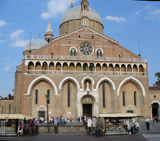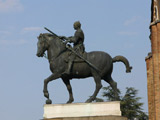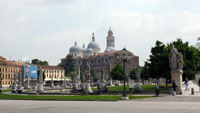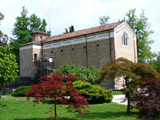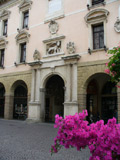Our tour began with an orientation and introductions in the breakfast room of our hotel. After that Nina led us on a short walk around the city.
Just around the corner of the hotel was the 13th century Basilica of St. Anthony, Gothic and Romanesque on the facade. This basilica contains the tomb of Saint Anthony with marble reliefs decribing his life. A chapel also contains relics associated with him.
Note: Click on any small photo to see a larger version.
The side of the basilica illustrates the Byzantine influence, with its eight Byzantine domes.
To the side of the church stands the equestrian statue of Gattamelata. Donatello, the talented sculptor of the Early Renaissance, who worked in Padua from 1441 to 1453, created the bronze statue between 1447 and 1453 in honor of Erasmo da Narni. The latter was commander-in-chief of the Venetian army (against Milan) and his diplomatic skill earned him the name of "Gattamelata" (spotted cat).
The Prato della Valle was once a Roman theater and later Anthony's preaching grounds. It is now an oval-shaped piazza with fountains and dozens of statues of Padua's eminent citizens.
Photo by Mike and Bernice Lincicum.
Nina then took us to a restaurant where we had our first group dinner which included risotto and white asparagus, pasta and pancetta for a first plate and osso buco and polenta for a second plate, followed by tiramisu for dessert.
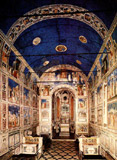 The next morning we walked to the Scrovegni Chapel which has nearly 40 frescoes by Giotto, sometimes called the Father of Western Art. Begun in 1305, the frescoes adorn a chapel which once stood next to an impressive palace belonging to the noble Scrovegni family. Noble they may have been, but not saints, and so the chapel was built as a token gesture for the forgiveness of the sins necessary for the family to make their fortune. You can follow the narratives of the lives of Joachim and Anna (parents of the Virgin Mary), Mary and Joseph, and Christ and His apostles which spiral around the chapel, covering its walls, studded with classical style allegorical figures of vices and virtues. At one end of the chapel is an dramatic portrayal of the Last Judgment, while everything is contained beneath the vaults painted as a star-filled deep blue night sky.
The next morning we walked to the Scrovegni Chapel which has nearly 40 frescoes by Giotto, sometimes called the Father of Western Art. Begun in 1305, the frescoes adorn a chapel which once stood next to an impressive palace belonging to the noble Scrovegni family. Noble they may have been, but not saints, and so the chapel was built as a token gesture for the forgiveness of the sins necessary for the family to make their fortune. You can follow the narratives of the lives of Joachim and Anna (parents of the Virgin Mary), Mary and Joseph, and Christ and His apostles which spiral around the chapel, covering its walls, studded with classical style allegorical figures of vices and virtues. At one end of the chapel is an dramatic portrayal of the Last Judgment, while everything is contained beneath the vaults painted as a star-filled deep blue night sky.
Giotto's fresco on the birth of Jesus, followed by two on the crucifixion.



Photos from www.christusrex.org
This is the Scrovegni Chapel from the outside.
This is part of the old wall of the palace belonging to the noble Scrovegni family.
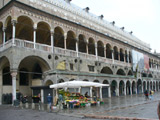 Our walking tour also took us past the Palazzo del Ragione, a Renaissance town hall building.
This building, with its great hall on the upper floor, is reputed to have the largest roof unsupported by columns in Europe; the hall is nearly rectangular and is about 260 feet long. The walls are covered with allegorical frescoes and the upper story is surrounded by an open loggia, The Palazzo was begun in 1172 and finished in 1219. After a fire in 1420 it was restored.
Our walking tour also took us past the Palazzo del Ragione, a Renaissance town hall building.
This building, with its great hall on the upper floor, is reputed to have the largest roof unsupported by columns in Europe; the hall is nearly rectangular and is about 260 feet long. The walls are covered with allegorical frescoes and the upper story is surrounded by an open loggia, The Palazzo was begun in 1172 and finished in 1219. After a fire in 1420 it was restored.
This is the front of the main building of the University of Padua. It was founded in 1222, making it the second oldest university in Italy, second only to Bologna. Copernicus and Galileo were two of its most famous professors.
 After lunch, some tour members visited the Baptistry of the Duomo. This Romanesque Baptistery (1075), named after St. John the Baptist, holds the finest cycles of frescoes painted by the Florentine painter Giusto de' Menabuoi in 1375- 1378.
The cycle begins with the wonderful Paradise and continues with the stories of St. John the Baptist, the Stories of Mary, the Passion, Death and Resurrection of Christ. To the left is an example illustrating the story of Jesus at the wedding in Cana.
After lunch, some tour members visited the Baptistry of the Duomo. This Romanesque Baptistery (1075), named after St. John the Baptist, holds the finest cycles of frescoes painted by the Florentine painter Giusto de' Menabuoi in 1375- 1378.
The cycle begins with the wonderful Paradise and continues with the stories of St. John the Baptist, the Stories of Mary, the Passion, Death and Resurrection of Christ. To the left is an example illustrating the story of Jesus at the wedding in Cana.
Some tour members also returned to the area of the Scrovegni Chapel to visit the archaelogical museum which contained Roman and Etruscan artifacts. Others visited the museum of decorative arts at the Palazzo Zuckermann, while many rested from a busy first day on the tour or looked for the first of many gelaterias.
The next day we had to be ready for the bus to Ravenna.

